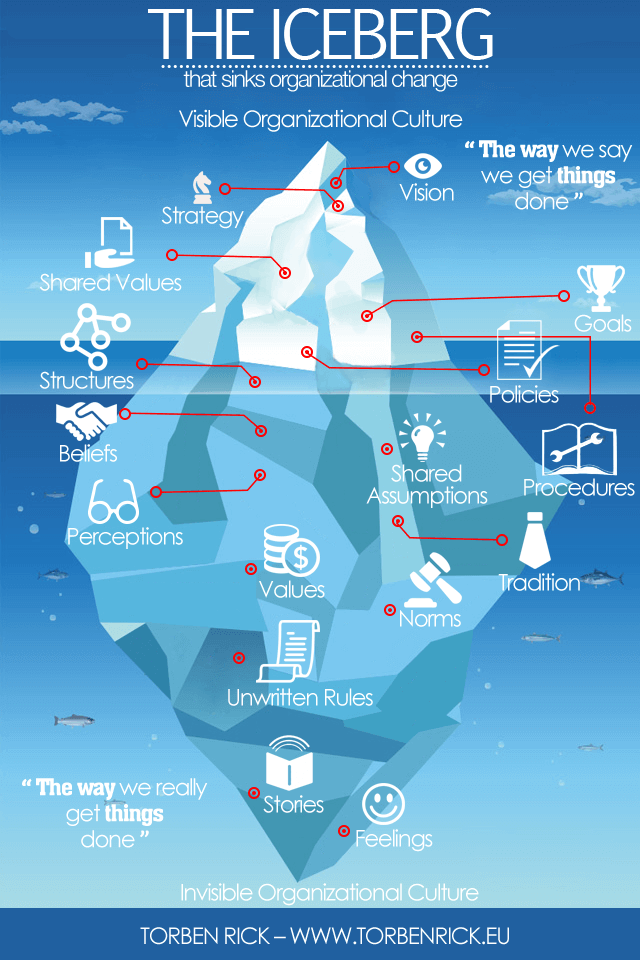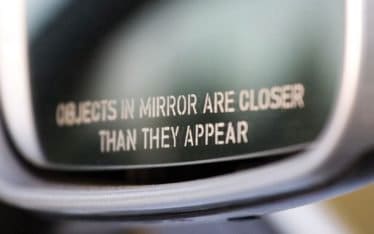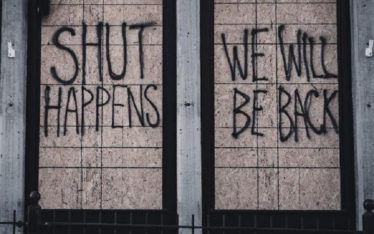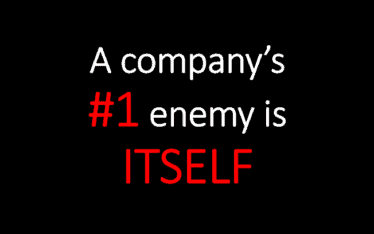How does the iceberg impact organizational change
While many aspects of change are apparent and obvious, there are also many more factors that are hidden under the surface, and more ubiquitous
Some aspects of organizational culture are visible on the surface, like the tip of an iceberg, while others are implicit and submerged within the organization.
Because these ingrained assumptions are tacit and below the surface, they are not easy to see or deal with, although they affect everything the organization does.
Most of an icebergs bulk lies below the surface. Ships that ignore the ice below the water are in mortal danger. Likewise, organizational change efforts may flounder because of a lack of organizational focus.
The iceberg that sinks organizational change
The change management iceberg is visualizing the essence of change in organizations: Dealing with organizational barriers. It is better to be mindful of things below the surface!

The iceberg that sinks organizational change – How does the iceberg impact organizational change
Before embarking on change make sure to understand the organizational culture! Don’t leave it unattended.
It’s like trying to build a house without a foundation – it’ll look good for a short while, until the walls fall down!
Changing an organization’s culture
Changing an organization’s culture is one of the most difficult leadership challenges. That’s because an organization’s culture comprises an interlocking set of goals, roles, processes, values, communications practices, attitudes and assumptions.
The elements fit together as an mutually reinforcing system and combine to prevent any attempt to change it.
“Strong” doesn’t mean fixed
A strong culture is vital for organizational success – but “strong” doesn’t mean fixed. As the organizational goals and strategy change over time, so too should culture intentionally be changed.
Short URL & title:
The iceberg that sinks organizational change — https://www.torbenrick.eu/t/r/jxm
Share it:
If you enjoyed this article, please take 5 seconds to share it on your social network. Thanks!








Thanks for the article Rick. You’ve mentioned culture as an interlocking set of elements. How much relative effort do you think management should put towards devising cultural strategies compared to the formal strategy?
@Benjamin – That’s hard to say – it dependence on the companies current organizational culture. But: “Five percent of the challenge is the strategy. Ninety-five percent is the execution”
What about corporate identity? Is this all together what is on this iceberg or might find place somewhere under the water? Thanks.
Ales
Mr. Rick: You said “The elements fit together as an mutually reinforcing system and combine to prevent any attempt to change it.” That is really true. Any organization, at any time, tries to make itself “perpetual” by making impossible even the smallest change.
I so agree with you. I think that organizational culture is one of the most important factors to handle, along with peoples feelings of uncertainty when it comes to change. Of course does every element you’ve mentioned in the iceberg matter, but with most of us, the feeling of uncertainty can make a huge impact on whether a change will succeed or not. This is often overlooked.
Torben, fantastic graphic, it’s one of the clearest on this subject I have seen. I have just used it as part of an article on culture change on my blog, linked to here of course.
See https://martindavis01.wordpress.com/2015/07/25/culture-the-iceberg-that-sinks-organizational-change/ for the article.
Hi Torben,
A very timely presentation for a client that I’m mentoring, experiencing many of the elements of resistance to change.
I’ve sat with the GM and we went through your 12 points and uncovered some real fundamental issues not only for the business but also for the GM to deal with in particular The Unknown!
Mange tak
Paul Martin
For a visual learner, your illustrations achieve the desired impact. Such a simple analogy about what you can see and address versus what is hidden and lurking in the depths, unless you consciously go looking for it.
The value is spending time ‘below the surface’; but not necessarily wearing scuba gear to do this, rather, taking deep breaths, gain an understanding and compare to the ‘above the surface’ visual elements. The question to ask is …. ‘How closely aligned are they?’
Nice work!
The graphic is pretty great, and I like how the spread of various traits makes sense. Their variations feel to line up with an article I recently wrote discussing how to keep open source organization culture going.
For me, there are seven traits that keep culture around, but they’re based on maturity and common sense. As such, I’ve found that you’ve got to have the right set of people in place and be willing to drop those who no longer fit fast.
This graphic is excellent, very helpful as I frame discussions with my leaders on a culture change we’re working on.
Thanks Karen
“A strong culture is vital for organizational success – but “strong” doesn’t mean fixed.” Ah, but so many confuse their security in an organization with its fixity and its fixity with its strength.